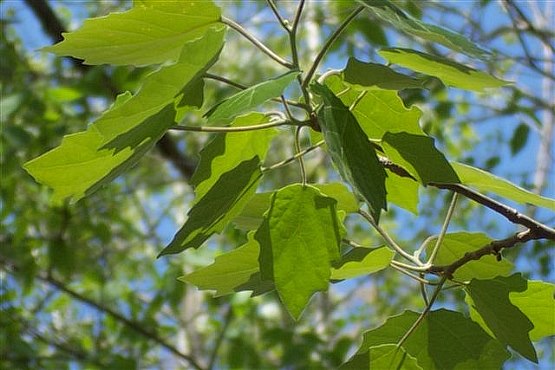
Big-Tooth Aspen is dioecious, developing male (staminate) and female (pistillate) flowers on separate trees. Male flowers are produced in drooping catkins about 2-4" long. Each male flower (about 1/8" or 3 mm. across) has a short disk at its base with about 12 stamens; each male flower is also accompanied by a bract that is deeply cleft into narrow ciliate lobes. Female flowers are produced in spreading or drooping catkins about 1½-3" long. Each female flower (about 1/8" or 3 mm. across) has a short disk at its base and a conic-lanceoloid ovary. At the apex of each ovary, there is a pair of stigmata; each stigma is deeply bifurcated. Each female flower is accompanied by a bract that is deeply cleft into narrow ciliate lobes. The blooming period occurs during mid-spring for 1-2 weeks; the flowers are cross-pollinated by the wind. Afterwards, the female catkins become slightly longer and the female flowers are replaced by conic-lanceoloid seed capsules up to ¼" long. Each of these capsules divides into 2 parts to release several tiny seeds that are embedded in tufts of fine white hair. The seeds are distributed by the wind. The woody root system is shallow and widely spreading; it often forms clonal trees from underground runners. The leaves of immature clonal trees tend to be larger in size and less prominently toothed than those of a mature tree. The deciduous leaves become pale yellow during the autumn.
Cultivation: The preference is full sun, moist well-drained conditions, and sandy loam. However, partial sun, drier conditions, and other soil types are also tolerated. This tree develops quickly and may live up to 100 years. In some situations, it can spread aggressively by developing clonal trees from underground runners.
Range & Habitat: The native Big-Tooth Aspen occurs occasionally in northern and east-central Illinois; elsewhere in the state, it is uncommon or absent. Illinois lies along the southern range-limit for this species. Habitats consist of upland woodlands and sandy woodlands, typical savannas and sandy savannas, disturbed open woodlands, riverbanks, and abandoned fields. Big-Toothed Aspen is a pioneer species that prefers disturbed areas that are not too shady. Mature trees are easily damaged by wildfires because of their thin bark. Nonetheless, Big-Toothed Aspen can rapidly spread after a wildfire because clonal trees soon develop from underground runners.
Faunal Associations: Big-toothed Aspen and other poplar trees (Populus spp.) are host plants of many kinds of insects. Insects that feed on them include larvae of metallic wood-boring beetles, larvae of long-horned beetles, leaf beetles, weevils, larvae of leaf-miner flies, plant bugs, aphids, armored scales, mealybugs, larvae of sawflies, larvae of Geometer moths, larvae of leaf blotch miner moths (Gracillariidae), larvae of owlet moths (Noctuidae), larvae of prominent moths (Notodontidae), larvae of clear-winged moths (Sesiidae), larvae of Sphinx moths, larvae of Tortrix moths, larvae of brush-footed butterflies (Limenitis spp., Nymphalis spp.), and larvae of a skipper, the Dreamy Duskwing (Erynnis icelus). More information about these insects can be found in the Beetle Table, Aphid Table, and Moth Table. Examples of insects that feed on Big-toothed Aspen include the Aspen Leaf Beetle (Chrysomela crotchi), European Snout Weevil (Phyllobius oblongus), Rusty Brown Aphid (Pterocomma populifoliae), a leafhopper (Kybos copula), Straight-lobed Scurfy Scale (Chionaspis ortholobis), larvae of the Virgin Moth (Protitame virginalis), and larvae of a butterfly, the Red-spotted Purple (Limenitis arthemis astyanax). Some species of birds and mammals use Big-toothed Aspen and other poplar trees as sources of food. The Evening Grosbeak, Purple Finch, and Ruffed Grouse eat the buds of Big-toothed Aspen, while the Yellow-bellied Sapsucker drills holes in this tree and sucks its sap. Birds that use this tree for protective cover and nesting habitat include the Black-capped Chickadee, Downy Woodpecker, Hairy Woodpecker, and Yellow-bellied Sapsucker (Degraaf, 2002). Mammals that feed on Big-toothed Aspen and other poplar trees include the American Moose (twigs, foliage), White-tailed Deer (twigs, foliage), American Beaver (wood, bark), North American Porcupine (wood, bark), Prairie Vole (bark of saplings), and Meadlow Vole (bark of saplings); see Martin et al. (1951/1961). A turtle, the Smooth Softshell, has been observed to feed on the floating seeds (Ernst et al., 1994). Finally, the Little Brown Bat (Myotis lucifugus) roosts in the cavities and behind the exfoliating bark of Big-toothed Aspen (Ludewig & Bowyer, 2012).

Photographic Location: A deciduous woodland in Fayette County, Illinois. The photographs were taken by Keith & Patty Horn (Copyright © 2010).
Comments: Big-Toothed Aspen is similar to Quaking Aspen (Populus tremuloides), except the latter has slightly smaller leaves (2-3" long) with more abundant smaller teeth (about 25 per side). It also resembles the more common Eastern Cottonwood (Populus deltoides), except the latter has leaves with truncate bottoms and more abundant smaller teeth. All three of these species have leaves with flattened petioles, which causes them to flutter in response to even a weak breeze. With the exception of the introduced Populus nigra italica (Lombardy Poplar), other Populus spp. in Illinois have leaves with round petioles. Occasionally, Big-Toothed Aspen and Quaking Aspen hybridize, which has been named Populus × smithii. This hybrid tends to have leaves with more teeth than those of Big-Toothed Aspen, but fewer teeth than those of Quaking Aspen.